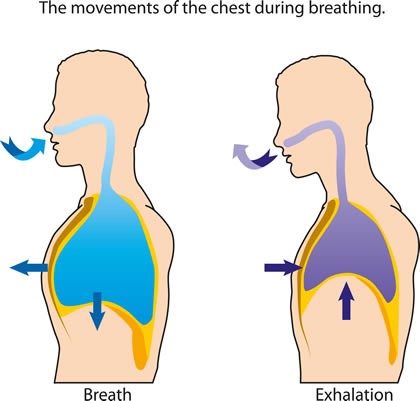 Pain Free Athlete
Pain Free AthleteThe diaphragm has a dual role in the body, respiration and posture. When these actions occur simultaneously, core stability is improved. This is particularly evident in the lumbar spine.
My last column, Breathe Well To Reduce Back Pain, described the diaphragm’s role in breath. This column will look at the how the diaphragm is central to a strong core.
How does the diaphragm produce core stability? Through pressure. When you inhale, the diaphragm descends into the abdominal cavity, reducing the pressure in the thoracic cavity which draws air into your lungs. The expansion of the diaphragm downward is countered by contraction of the transverse abdominis to the front, the multifidi (spine muscles) to the back and the pelvic floor (pelvic diaphragm) below. The increased intra-abdominal pressure creates a round core in your torso which provides stability. If breathing is shallow, this pressure will not travel low enough to secure and protect the lumbar spine, leaving it vulnerable.
So, your core is not one muscle alone but four – the respiratory diaphragm, transverse abdominis, multifidus and the pelvic diaphragm. Core stability is produced through pressure and the coordinated movement of these four muscles. If everything is working right this system of muscles activates before you move to prevent compensations (muscles doing actions for which they were not intended). Moving from a strong, stable center allows efficient, pain free activity. Unfortunately, for many this is not the case and the superficial muscles take up the slack and become overworked and painful. The body wants to help you do whatever you want to do even at the expense of inflicting harm to itself.
The diaphragm is a skeletal muscle
Just like your biceps or hamstrings, the diaphragm responds to conscious control and can be strengthened with exercise. The flip side is that it can also be under stimulated and weak. The diaphragm is strengthened through breathing. In a natural breath, the lower lungs fill first, expanding your ribs outward in all directions near the level of your belly. Next, the breath will move up toward the heart and finally into the chest, raising the ribs. Envision a wave of air moving from your belly to your throat. Exhalation follows the same pattern in reverse. The air in the chest is released first and progresses down to the belly. Stress, fear and anxiety can interrupt our natural breathing pattern, resulting in a predominance for chest breathing. This not only jeopardizes core stability but also reduces breathing capacity, the essence of life. Train your diaphragm and enhance your respiration and core strength by practicing the following progressive breathing exercise.
Global Breathing Exercise
Start by lying on your back with your knees bent in a comfortable position. This exercise takes you through specific breathing focus areas which are then combined.
Focus 1: Expand your breathing forward and backward. Feel your lower lungs fill with air and your lower torso grow bigger front to back. You should feel increased contact with your back on the floor as it fills with air.
Focus 2: Expand your breathing up and down. Imagine breathing along the length of your spine, stretching it from each end.
Focus 3: Expand your breathing side to side. Place your hands on your sides just above your lowest ribs and press in slightly. Breathe into your hands, pushing them away from your body as you inhale.
Focus 4: Breathe in all three directions simultaneously.
Focus 5: Emphasize the lift of the pelvic diaphragm which works in tandem with your respiratory diaphragm. Upon exhale perform a slight upward pull of your pelvic floor (Kegel) as the respiratory diaphragm also moves up.
Focus 6: Lengthen your exhale and feel your deep abdominal muscles contract to push the air out of your lungs. Your exhale should be twice as long as your inhale.
Breathing happens whether we are aware of it or not, thank goodness! Tuning into your breathing regularly and practicing this exercise once daily will elevate your awareness and strengthen your breathing muscles. Better breathing can elevate your aerobic endurance, correct your posture, boost your mood, improve your movement efficiency and raise your energy!
Jessica Kisiel is local wellness professional specializing in injury recovery and pain management through posture alignment. She is an Advanced Exercise Therapist certified by Egoscue University® and integrates Postural Respiration into her therapy. Stay connected and receive free posture exercises here: http://www.thepfathlete.com/subscribe.

